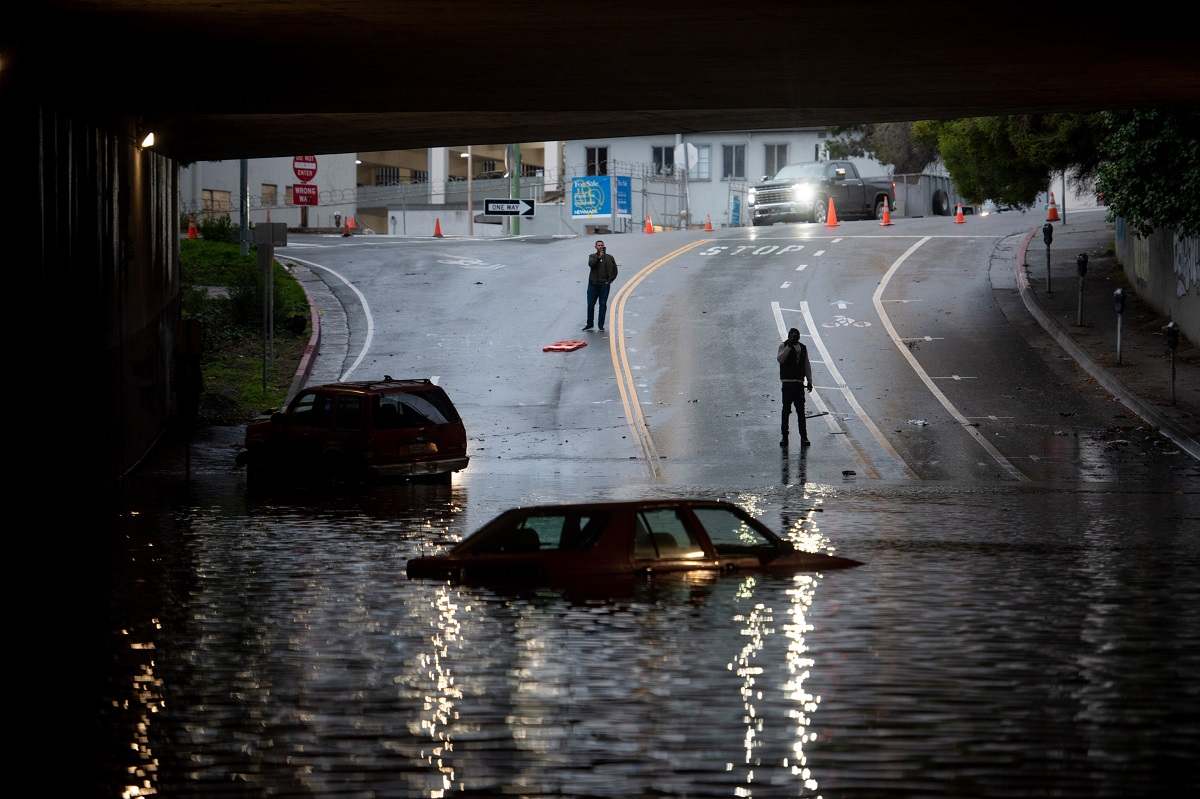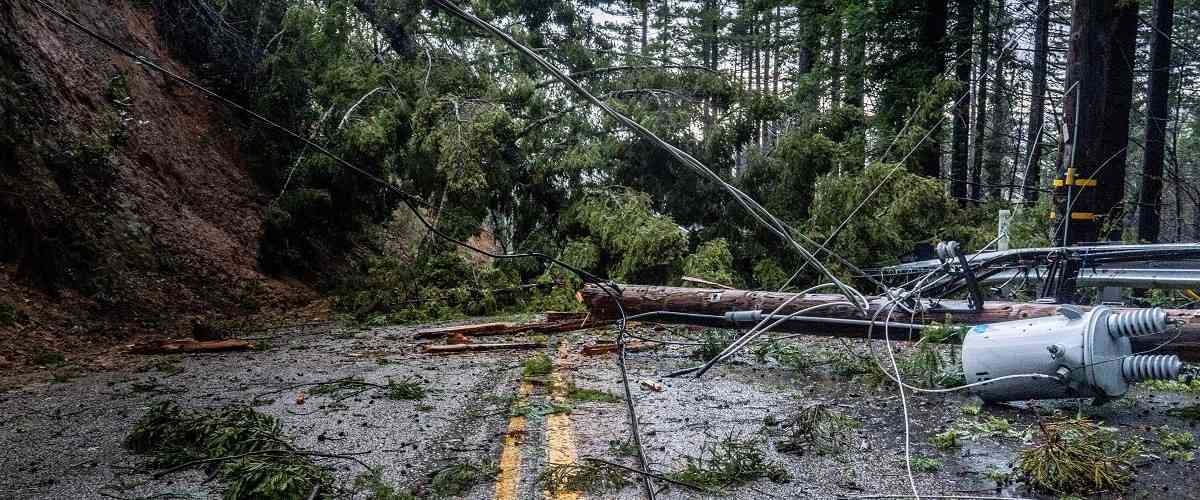
People photograph a car sitting in flooded water at an underpass on Jan. 4, in Oakland, Calif.
12:51 JST, January 16, 2023
Relentless wind and rain has killed people sleeping in homes and in tents. It has taken the lives of those sheltering indoors and those working outside. Some victims have been elderly, others very young. And they are spread across 10 California counties and more than 500 miles, one measure of this disaster’s massive, difficult-to-manage scope.
After two weeks of nearly nonstop downpours, the official statewide death toll from multiple atmospheric rivers stands at 19. That figure will rise, authorities say, but already it is greater than the number of people killed during the last two fire seasons combined. The parade of storms has been deadlier than any single wildfire since 2018, a jolting fact for a state whose worst recent disasters have been the product of too little water, not too much.
And it’s not over. At least two more storms have California in their crosshairs. Once the skies clear and the floodwaters finally recede, emergency managers expect this spate of tempests to rank among the deadliest natural disasters in state history.
Experts say the toll reveals an unfortunate reality: After so many years of drought, some Californians are unaccustomed to the dangers of rain.
“Water in some ways seems more innocuous than a fire bearing down on you or an earthquake shaking a whole city, but water – as proven by this event – can be just as deadly,” Brian Ferguson, a deputy director of California’s emergency services office, said in an interview.
Local officials have identified nearly all of the storm victims, and their backgrounds are a cross-section of the diverse state: A Mexican American father who danced to banda music as he cleaned the house; a woman who emigrated from Hong Kong as a teenager and was days away from renewing vows with her husband of 15 years; a Midwest transplant and mother of five who fell into homelessness and cooked every day for her friends in their riverside encampment.
The youngest victim was 2-year-old Aeon Tocchini, who was on the couch when a redwood crashed through the roof of his family’s double wide in a small Sonoma County town. Aeon’s father emerged from the wreckage battered but alive. Had the tree come down just minutes later, his mother, returning home from work, would have been inside with them.
Another young boy, 5-year-old Kyle Doan, is still missing. Kyle was separated from his mother when the pair tried to escape from their truck as it washed down an overflowing creek. The last thing he said, his father recounted: “Don’t worry, Mommy. It’s okay. Don’t panic.” Nearly 200 rescuers have been searching for Kyle along the creek in San Luis Obispo County, where he was last seen. So far, they’ve only found one of his Nike sneakers.
Most of the storm’s other fatalities have been among older individuals. Of the 16 people for whom an age is known, about a third were over 60.
The first deaths to be attributed to the storms occurred in late December, when a rockslide at Yosemite National Park sent 185 tons of rubble tumbling onto a married couple visiting from San Jose. The force of the fall pushed their rental truck onto a nearby river embankment.
For the first week and a half of 2023, at least one death was reported nearly every day.
Seven people have been found in floodwater, two of them in submerged cars, and first responders say they probably drowned. Five people have been killed by falling trees or branches, their structures weakened after years of drought. And five others have died in car crashes.
Californians have faced plenty of intense storms, but in recent years, the worst calamities have been historic, apocalyptic fires. Sometimes tragedy comes down to people being rusty, said Ferguson, with the state emergency office.
“Among the public, some of the muscle memory of how to be prepared for a storm may not be there,” he said. The challenge of influencing human behavior – convincing people to evacuate or to turn around when they see a flooded road – is “something that keeps me up at night,” Ferguson said.
The state’s years-long drought may have also had a psychological effect on residents, who lately have been praying for rain, said Amir AghaKouchak, a civil and environmental engineering professor at University of California at Irvine.
“Fire, when you see it, you immediately feel the danger,” he said. “But rain is different, especially in California, where we consider it a good thing.”
Floods, then, can blindside people, he said. And it doesn’t take much water – sometimes just a quarter of an inch in a matter of minutes – to transform a benign hill into a mudslide, AghaKouchak said.
“That’s enough to create a human disaster,” he said.
Making conditions riskier, the recent wildfires have left more land than ever scorched and scarred, one heavy rain away from a catastrophe. California is seeing the deadly consequences of cascading climate disasters, AghaKouchak said, and a preview of its future.
If the toll from this series of atmospheric rivers continues to increase, it could soon surpass the 2018 mudflows in Montecito that killed 23, making it the state’s deadliest storm disaster since a 1939 tropical storm that devastated Southern California. Though the recent winter weather is the result of multiple storms, officials are combining them when calculating the death toll because they’ve come in such quick succession.
“The unique challenge of these storms is they hit so many parts of the state at the same time,” Ferguson said. “Wildfires are typically limited to one, two or three counties. Right now, we have 41 counties under disaster declaration. That’s the equivalent of a hurricane that hits five states along the Eastern Seaboard.”
While the ferocious gusts and fast-rising waters appear to have impacted Californians across social strata, those most at risk have been residents living on streets, in parks or along waterways, who often sleep in flimsy tents or atop cardboard.
More than 170,000 people who live in the state are homeless, and more than two-thirds are unsheltered, the largest share in the country, according to a federal report.
“Those living in our streets may be living on cardboard, they may be living in a tent that can’t withstand the kind of weather we’re having – it’s cold,” said Georgia Berkovich, the director of public affairs at the Midnight Mission, a long-running human services organization in Los Angeles’s Skid Row. “There’s no place to go.”
There are only so many beds available in shelters, she said, and in torrential rain, even handing out blankets and extra clothes can feel futile: “Those are only good until they get wet, and if they’re wet, that can get you sick faster, because instead of making you warm, it gets you cold.”
The Midnight Mission has seen two unsheltered community members die after being out in the rains that deluged Los Angeles’s usually sunny streets, Berkovich said. Those fatalities haven’t officially been attributed to the weather, nor are they included in the state total, but they show how the storms have exacerbated the already precarious situation of the state’s most vulnerable.
In Sacramento County, two of the five storm deaths have been among the local homeless population, despite officials’ efforts to encourage people to seek shelter. Authorities targeted high-risk encampments along the American River, flying helicopters overhead and going tent to tent on foot advising people to leave, said Kim Nava, the county’s spokesperson. At peak capacity, nearly 150 people took refuge in county shelters and more than 360 used government-provided motel vouchers.
But in the worst conditions, another group was uniquely at risk: emergency personnel.
People like Edgar Castillo, whose jobs start when disaster strikes.
Castillo’s last post to social media was a selfie taken from a hotel room in the Northern California city of Ukiah, where he was dispatched to help PG&E clear roads and repair downed power lines. “Grindtime,” he wrote at 4:41 a.m., mugging in the mirror, clad in black overalls and a fluorescent yellow jacket.
“He had so many pictures of himself in his work stuff,” his wife, Leticia Ramirez, said in an interview. “I’ve never seen anyone prouder to wake up at 4 a.m. and travel that distance just to work in that weather and do what he did.”
Castillo, 37, was a Class-A driver who worked at a company that was frequently contracted for jobs like this. It was a union position with great benefits, and he loved knowing he was helping people – getting power back on, maybe saving lives.
After he took that selfie, on the morning of Jan. 7, he set out in his boom truck with a co-worker. They made it about 50 miles southwest, near the town of Manchester, not far from the Pacific coast. It’s not clear what exactly happened, but at some point, the truck veered off the road and rolled over, killing Castillo and injuring his co-worker.
Ramirez woke up later to a text from her husband, sent around the time he set out that day: “Good morning, my love,” it said. By then, he was already gone.
The week since has been a haze, Ramirez said, but she keeps thinking about all the ways Castillo cracked her up. Like the time he did a dance with a plate of barbecue chicken, trying to cheer her up on the anniversary of her father’s death. Or the way he’d groove while mopping the floor in their Elk Grove house, which he had spent years saving up to buy.
Castillo treated all of the family’s kids as his own, the three Ramirez had before they met and the twins they shared, she said. He had begun teaching their teen daughter to drive – a fact that comforted Ramirez, who used to poke fun at the way Castillo would navigate the family minivan, slow and steady, “like a grandma,” she said.
The twins, who are 5 years old and have developmental disabilities, would light up when Castillo came home from work, and then follow him around the house, from the front door to the shower.
When Castillo first got the call to go into the storm, Ramirez wanted him to turn it down. She had a bad feeling. But the couple needed the money and he couldn’t be out a week of work.
Their last conversation was the night before his death, when he called her from Ukiah. It was short, and Ramirez remembers every word. After three minutes, she told him she had to go tend to one of their children.
“We said, ‘Goodnight, I love you,’ like we always do,” she said. “And that was it.”

Fallen redwood trees cover the roadway in Santa Cruz, Calif., on Jan. 10.
"News Services" POPULAR ARTICLE
-

American Playwright Jeremy O. Harris Arrested in Japan on Alleged Drug Smuggling
-

Japan’s Nikkei Stock Average as JGB Yields, Yen Rise on Rate-Hike Bets
-

Japan’s Nikkei Stock Average Licks Wounds after Selloff Sparked by BOJ Hike Bets (UPDATE 1)
-

Japan’s Nikkei Stock Average Buoyed by Stable Yen; SoftBank’s Slide Caps Gains (UPDATE 1)
-

Japanese Bond Yields Zoom, Stocks Slide as Rate Hike Looms
JN ACCESS RANKING
-

Keidanren Chairman Yoshinobu Tsutsui Visits Kashiwazaki-Kariwa Nuclear Power Plant; Inspects New Emergency Safety System
-

Imports of Rare Earths from China Facing Delays, May Be Caused by Deterioration of Japan-China Relations
-

University of Tokyo Professor Discusses Japanese Economic Security in Interview Ahead of Forum
-

Japan Pulls out of Vietnam Nuclear Project, Complicating Hanoi’s Power Plans
-

Govt Aims to Expand NISA Program Lineup, Abolish Age Restriction



















